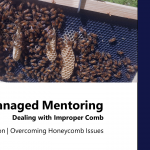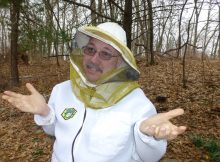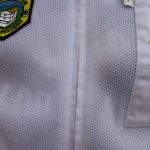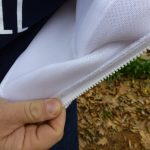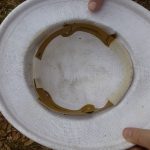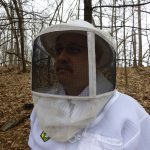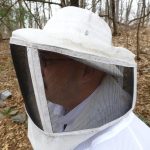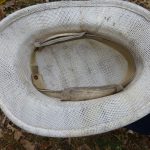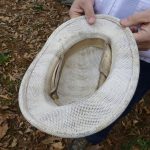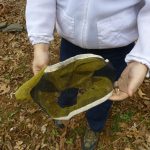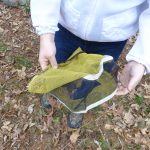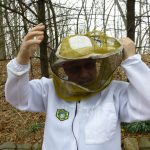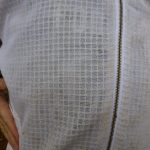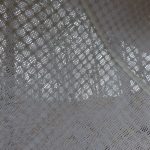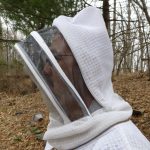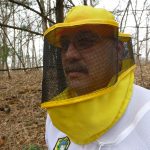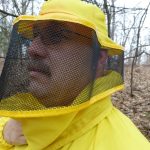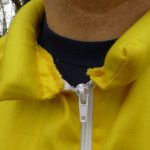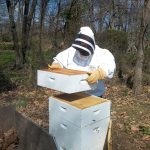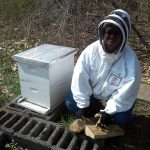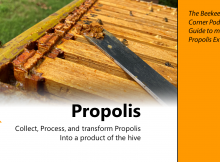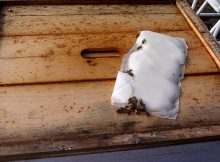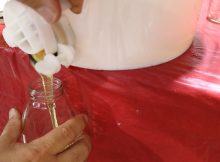Beekeeping Suits
I see the question about beekeeping suits or garments come up quite a bit. We have been keeping bees since 2008 and over time we’ve accumulated a handful of outerwear – veils, jackets, gloves, and such. In this post, and as part of my ‘what do I use’ series, I will talk about beekeeping garments and my impressions.
Recommendation – take a look at the gallery of photos prior to starting – you’ll see images of most of the equipment that I’ll talk about below.
My favorites
Jacket: UltraBreeze beekeeping Jacket – ultrabreezesuits.com
Veil: A beekeeping veil procured from a small shop in Italy (sorry, can’t provide a link to this one). Alternate choice is my Kelley Veil
Gloves: Blue Extra Large Nitrile Gloves (find them online or at drug stores)
What we have
Mann Lake ‘Pollinator Brand‘ Jacket with hood style veil (x2)
Ultra Breeze Jacket with hood style veil
Italian (Co-op Melissa Company) Custom Beekeeping Jacket and Veil, picked up on a trip to Italy
Brushy Mountain ‘Ventilated Jacket‘ without veil
Kelley Veil and Helmet – sorry not sure what model
Various other veils of undetermined origin
Veil from Italian (Co-Op Melissa Company) that is designed to work with the Co-Op bee suit (yellow) mentioned above
Canvas wrist length gloves
Blue, Xtra Large Nitrile gloves
What you are doing – Right tool for the job
What you wear is an It Depends Situation
I don protective equipment based on the scenario I am facing. Factors like the time of day, type of work, and other aspects do matter when you are planning your beekeeping activities. The beekeeping season runs from March to December in New Jersey but much of it is done in the warm spring and summer months and trying to stay cool becomes as important in some factors as being protected.
Solid Canvas Jackets
We started beekeeping with Mann Lake canvas jackets. These are professional tools. Solid, well constructed, durable, but hot. If they were not hot, they would be a very solid choice. We have several of these and in the cooler times they are actually sometimes a go-to choice because they provide protection and warmth.
Protection – Can you be stung?
One common question is can you be stung through a beekeeping jacket or suit; yes, it is possible not very common. An important aspect of protective outerwear that I think goes unnoticed is all stings are not the same. The amount of penetration of a sting, in my experience, determines how severe the sting is. So one aspect of protection is if you are stung while wearing protective outerwear can the stinger get to your skin and if so how far can it penetrate. The material and construction of protective outerwear can impact this greatly.
One aspect of the Ultrabreeze Suit is that the three layer design is so deep in thickness that the stinger in principle cannot reach your skin. Bee biology, and the length of a bees stinger, dictate that it can’t reach. That being said, it is possible that the suit can be compressed and people have told me that they have had some circumstances where they’ve been stung through a mesh suit design.
Mesh Style Suits – They are not all created equal
The first mesh style suit I came across was from a beekeeping forum of all things. A guy named Bill had an idea, and beekeepers were doing a indegogo style campaign for him before indegogo was a thing. Uncharacteristically I got in on the order of a not for sale product and ordered my suit through a collective order that someone arranged. I was hesitant at jumping in but in the end the design of the suit had so much potential that I couldn’t reason why it would not revolutionize if it held up to its claims. On a rare occasion, it did.
Three Layers Is Right
Why it works…. The Ultrabreeze mesh design uses three porous weaves layered on top of each other and create the depth that I mentioned above. It has a fine mesh layer inside, a waffle like layer int he middle, and a durable perforated outer shell. It takes some getting used to the bulkiness of the design at first but they float well enough over each other that they are actually less constraining In My Opinion (IMO) then a canvas jacket. It takes some getting used to but after a short adjustment it goes unnoticed, at least it did for me. I’ll reiterate that I’ve never been stung.
One Layer, not so much
Newer designs have emerged after this style of suit came on to the market. My Brushy suit has a fine mesh layer inside and a foamy style perforated layer on the exterior. It is similar in design to the “Frog Tog” brand jacket that I knew of through exposure in a different manner (my twin was a dealer in early days). FrogTog jackets were breathable material made of something akin to Tyvek but had perforations to let moisture out but no rain could get in. This material is different then FrogTogs but the holes have a similar appearance.
I was drawn to the design because upon checking out the jacket in person it felt as lightweight and seemed in principle to be breathable like my Ultrabreeze so I bought one. While it does affort more some breathe ability it does not IMO afford the same level of protection and comfort. I have been stung through this jacket and it simply does not allow air to flow as well as the Ultrabreeze style suit. It is not a bad jacket, and on occasion when it is not cold, nor really hot, it makes for a good choice. It is lightweight and if I had to choose between the Mann Lake canvas suit and this one, I probably would choose this one second simply for it’s utility.
Airflow
No question about it. The first time you’re standing out in the apiary on a sweltering hot day and the slightest breeze comes along you’ll thank your ultrabreeze suit. It is like a little gust of freshness from angels. I have not felt the air move through my perforated single layer poly jacket and suspect it is helpful for letting heat out but little use for letting a breeze in. I’m so confident in my ultrabreeze suit’s protection that I would go bare skinned under it if need be – don’t picture that you’ll burn out your corneas…. 😉
Veils / Hoods
Hoods vs. Veils
The MannLake and Ultra Breeze jackets comes with what is labeled a veil but I think it should be called a hood. In my estimation a veil is a piece of cloth and mesh that hangs over your head whereas a hood is a canvas cover that has a mesh front for you to see through and it covers the back of your head. To say that in a different way, a veil has mesh all the way around, 360°, and a hood does not. Both of my jackets have hoods that can be unzipped from the jacket and are not permanently attached.
Veil Styles
Surprisingly I hand’t thought much of this but have quite a few of these and in different styles.
Hat Style
The first and last ones I came upon are simply cloth tops that sit directly on your head like a cloth hat, have a wide brim, and mesh hangs down to create the veil. These are one piece affairs with a drawstring or gathering at the bottom that hang low enough to cover your neck and are designed to go over a collar.
I’m not sure what it is about the Italian veil but it simply hit the right notes. It is lightweight, it has a really nice screen, and it fits me well and is comfortable to wear. I always find the helmet style doesn’t feel well – kind of like a poor fitting bicycle helmet. The Italian veil sits right on my head like a form fitting baseball cap, and it might look as if a bee could sting my scalp, but touch wood they’ve never stung me through the part that sits on my head.
Helmet Style
Another style that I have is the tradition helmet and veil combination. This is a rigid helmet, two that I have are plastic, and one is a woven straw like weave. Over them is a cloth and mesh enclosure that has a hole for the top of the helmet to mate with and again a typical drawstring enclosure at the bottom.
Materials
It’s about the mesh. Predominantly there are two or three materials for mesh. What matters is the type of material ‘grid’ and color. Veil mesh materials, at least the ones that I have, are made from a cloth weave, wire, and for one a plastic mesh. The patterns are usually little squares. Like trying to look through a screen door, the color of the material and its density determine how well you can see through it to identify what you are looking at. What works is different for everyone and by that I mean I wear glasses and the focal length determines how I see through the screen. My conjecture on this is see if you can buy a veil in person, and see if you can look through it before you buy it – preferably in natural light.
Gloves
Canvas and Nitrile
I have learned to go glove-less. It was an objective of mine as a beekeeping practice. I loathe being stung on the finger tips so going glove-less has forced me to slow down and for that reason I think I am a better beekeeper. When and if I feel I need gloves I reach for the nitrile.
Like bee suits, wearing gloves may not prevent you 100% from being stung on the hands but it does in so many instances lessen the impact. The depth of penetration often dictates how bad you react to a sting and wearing something often presents enough of a barrier to prevent the depth of sting you might have encountered if you were bare handed.
Nitrile
When and if I feel I need to use gloves I go for the Nitrile. They are the closest thing to being bare handed. I have really large hands, and at times I don’t like the gloves for they are really taught for me. I’ve found bigger nitrile glove sizes so I have less tears but I still feel a little confined and my hands sweat when it is hot out. Still they offer good dexterity and sting protection. Another factor that many learn to consider is stains on your hands. Propolis and other hive substances are hard to clean off and wearing gloves keeps your hands clean.
One bad side effect of wearing these disposable gloves is waste. I’m not a fan of disposable and the environmental impact. I judge when I am going to use them and although some would consider it a bad practice, I do wear my gloves when going between hives.
Considering waste, a listener has suggested that one could use dishwashing gloves. I’m good with that suggestion but generally find it does not work for me. Dish washing gloves are not make for people like me with such large hands so I will stick to the nitrile and dislike the waste.
Canvas and Cloth Gloves
Canvas
Somewhere along the line, probably when we got started, my wife picked up a pair of canvas gloves for beekeeping that go to your wrists. They are really nice gloves for the purpose as the material is thick enough to afford protection but thin enough to allow your fingers to bend and have some dexterity. Still, as a beekeeper they are too clunky and it is too easy to crush bees and mishandle equipment due to loss of dexterity. If however the bees are testy, or I’m doing something where you have to have full protection – say a cutout or other activity, these are my go to gloves. If you’re buying gloves think about buying something that is not as protective as you would want. Meaning, don’t buy these thick, behemoth, you’ll never be stung through them gloves. It will not go well for you. Simply having canvas or leather gloves made of a thinner material will afford you almost all of the protection you’ll need.
Cloth
Over the years I’ve used mechanic gloves with great success. For the same reason nitrile work, they are made for dexterity. They don’t offer the greatest sting protection but they do offer some and negate those deep painful stings on almost all occasions. It is not a bad idea to have some of these in your kit.
Equipment Maintenance
Suits, Gloves, some Veil Materials
Suits
The canvas suits from Mann Lake and Italy can be washed in the washing machine like any other material. The Ultrabreeze suit should be washed like a delicate and it’s hood should not be put into a washing machine. With the ultra Breeze jacket it says that it can twist between the layers and they recommend that you shake it out before it dries and ensure it is flattened and in shape before allowing to dry fully.
Veils
The hardest part with the veils is keeping the screens in shape. Since some that I have are made of wire mesh, if squeezed, or equipment set on them, they get misshappen. I try whenever possible to store them in a place where things will not be set upon them and squish them. Otherwise just taking care of the draw srtrings is something to look after.
Cleanliness
The Ultra Breeze suit has grayed some but is holding up well. Like most bee suits it was very white when I bought it and now it is a dull white. The Brushy Mountain mesh jacket looks terrible. Washed or not it has stains and looks like it has been on the floor of the closet and walked on. Every stain, every spatter stays in the material for some reason. The Mann Lake jackets have lost their bright white and show wear but generally look kept after coming out of the washing machine. I try to make it a practice to wash them once or twice a season.
Don’t ‘dryer’ anything
I don’t like to use the dryer for anything. I’m simply not going to take the chance to damage anything and it is no bother to hang them on a line outside and let them air dry.
Conclusion
Nothing could be more personal than clothing and especially clothing that protects you from possible stings. The truth is the farther I get into my beekeeping tenure the less I wear protective clothing. I will say that a responsible beekeeper always wears a veil and I’m am guilty of not following that sage advice. Most times I gauge the mood of the bees and take into consideration what activity I have planned, and then wear the protective equipment accordingly.
All beekeepers will tell a tale eventually of a situation where they were caught off guard and some beekeepers I know simply go out in full regalia every time and never chance fate. You’ll need to learn where the sweet spot is for you but hopefully this detailed review of what I do, and what I’ve learned can be helpful.



